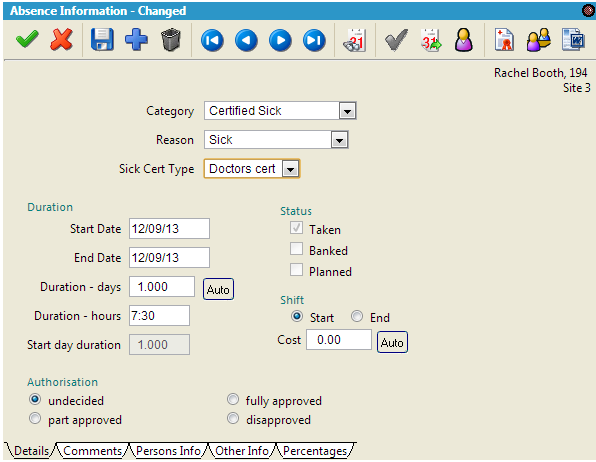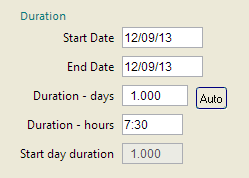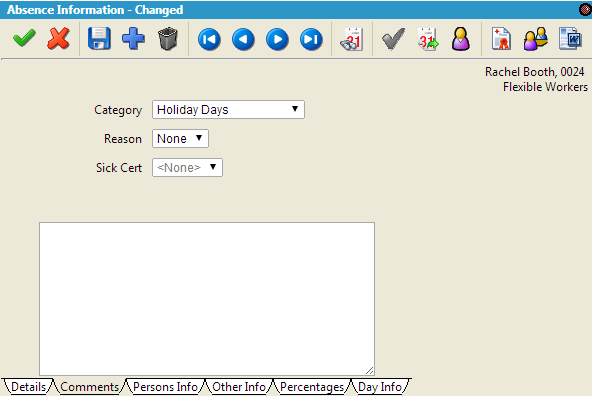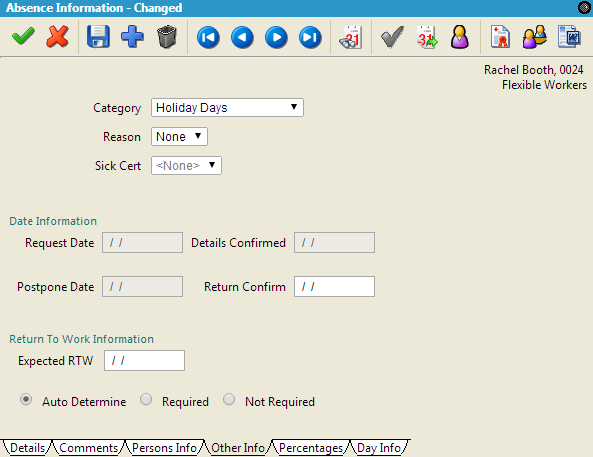Absences are stored and created in the absence screen. There are three tabs in the absence screen, however in most cases only the first tab “Details” will be used.
It is important to note, the two additional tabs in the image below; Persons Info and Percentages relate to the AbsenceWise Module
To select an absence category, click on the category drop down list and select the option required. Depending on your organisation requirements, more or less information may be required when entering an absence. For instance, if an absence of the category “Holidays” has been entered, normally it is not required to have a reason to go on holiday, as seen in the image above. However, if the absence is for “sickness”, then a reason may be required, and even a sick cert; as seen below

The absence categories that can be selected can be added by a superuser in the Softworks Configuration Utility, along with the reasons for the absence and sick cert status.
When a new absence is entered, a default category is selected, usually this is set to “Holidays”.
To set the duration of an absence, type in the Start Date and the End Date.
An absence must have a fixed duration or length of time. Even if the absence end date is not known when it is entered, date parameters must be set. A start date and an end date must be selected, and these dates are both inclusive in the absence. For example, in the absence entry seen in the image below, it is from 10th November until the 13th November. This will cover the date’s 10th/11th/12th/13th.

Once the start and end dates have been entered, a duration in days and hours will be seen. If this is not refreshed automatically, click on the “Auto” button. This length of time is automatically calculated according to the roster that the employee is working. It calculates working days and hours according to what they are rostered to work during those days.
N.B – In some cases it may not be possible to predict how many working days/hours an employee will miss in advance, as this is not know at this time. In these circumstances, absences are normally entered in on a daily basis.
It is possible to enter manually the amount of days or hours that are required into the days/hours field, however this will only work with a one-day absence. For example, if an employee is absent for half a day, 0.5 days may be entered into the days field.
The Starting Day Duration field allows for more complex absence settings, and caters for the first day of the absence not being a full day.
To set the authorisation status for an absence, click on the required authorisation level.
All absences entered into Softworks will have an authorisation status. Some organisations choose not to change the status of the Authorisation from “undecided” as it is not seen as necessary. It is recommended that absences are given the correct authorisation status as it the “view authorisations” icon will become active, and it can be seen which user authorised the absence.

Depending on how your organisation works, you may be required to use different settings here
If employees enter their own absences into Softworks, they will not be able to set the authorisation status. This will be activated by a supervisor, who will set the absence to either “Fully Approved” or “Disapproved”.
If the supervisor adds absences into Softworks, then nearly all absences should be recorded as “Fully Approved”. The reason for this is that most absence requests that are denied, do not make it as far as the Softworks system and are denied by the supervisor.
The status of the absence is also listed on the absence screen. There are three possible settings here:

Taken: This means that the absence in question is official and will be deducted from a balance if required. For example, if a holiday is set to “taken”, it will then be deducted from the employees holiday balance
Banked: this only applies to absence entries that increase a balance. For example, Time in Lieu Earned is recorded in Softworks as an absence, and an hours entered under this category are considered as “banked” as they increase the balance
Planned: this means the absence is planned and will not deduct from the balance of the employee. This is used in organisations that allow employees to enter absences themselves, and usually the supervisor authorises these, which changes their status to “taken”.
It is possible to enter comments manually for an absence. Clicking on the “Comments” tab on the absence screen shows a window where comments may be entered:

If an absence has comments previously entered into the comments tab, then the Comments tab title will be highlighted in capital letters.
The Other info tab contains information regarding “Return to Work” settings. The “Return to Work” information is regarding a “Return to Work” interview that organisations conduct upon an employees return to work after an absence. For instance, an organisation may need to interview an employee after they have been on sick leave for 3 days, to confirm that they are able to do their work again, and that they are fit for normal duties. If your organisation does not use “Return to Work” interviews, then these settings do not need to be used.

The “Expected RTW” field sets the date for the employees expected return to work. A report can then be run that will flag the need for a return to work interview for the employee.
The “Expected RTW” can also be set to either “auto determine”, “required” or “not required”. If it is auto determined, then it depends on the settings of the absence itself. This is set up in the configuration utility. It may also be set to required or not required manually, which overrides the settings in the absence.